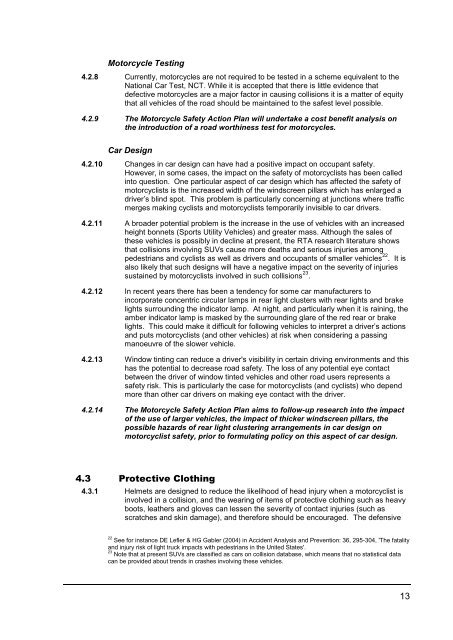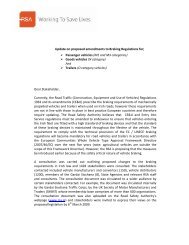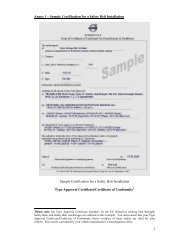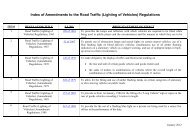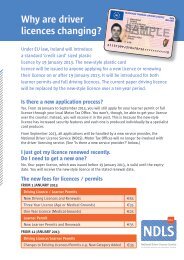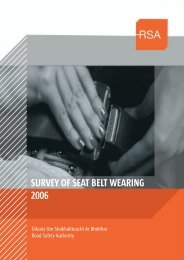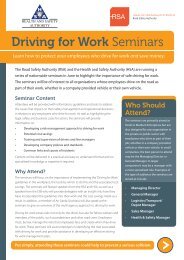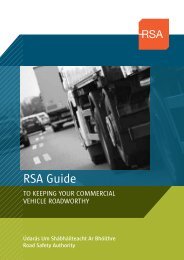National Motorcycle safety action plan - Road Safety Authority
National Motorcycle safety action plan - Road Safety Authority
National Motorcycle safety action plan - Road Safety Authority
Create successful ePaper yourself
Turn your PDF publications into a flip-book with our unique Google optimized e-Paper software.
<strong>Motorcycle</strong> Testing<br />
4.2.8 Currently, motorcycles are not required to be tested in a scheme equivalent to the<br />
<strong>National</strong> Car Test, NCT. While it is accepted that there is little evidence that<br />
defective motorcycles are a major factor in causing collisions it is a matter of equity<br />
that all vehicles of the road should be maintained to the safest level possible.<br />
4.2.9 The <strong>Motorcycle</strong> <strong>Safety</strong> Action Plan will undertake a cost benefit analysis on<br />
the introduction of a road worthiness test for motorcycles.<br />
Car Design<br />
4.2.10 Changes in car design can have had a positive impact on occupant <strong>safety</strong>.<br />
However, in some cases, the impact on the <strong>safety</strong> of motorcyclists has been called<br />
into question. One particular aspect of car design which has affected the <strong>safety</strong> of<br />
motorcyclists is the increased width of the windscreen pillars which has enlarged a<br />
driver’s blind spot. This problem is particularly concerning at junctions where traffic<br />
merges making cyclists and motorcyclists temporarily invisible to car drivers.<br />
4.2.11 A broader potential problem is the increase in the use of vehicles with an increased<br />
height bonnets (Sports Utility Vehicles) and greater mass. Although the sales of<br />
these vehicles is possibly in decline at present, the RTA research literature shows<br />
that collisions involving SUVs cause more deaths and serious injuries among<br />
pedestrians and cyclists as well as drivers and occupants of smaller vehicles 22 . It is<br />
also likely that such designs will have a negative impact on the severity of injuries<br />
sustained by motorcyclists involved in such collisions 23 .<br />
4.2.12 In recent years there has been a tendency for some car manufacturers to<br />
incorporate concentric circular lamps in rear light clusters with rear lights and brake<br />
lights surrounding the indicator lamp. At night, and particularly when it is raining, the<br />
amber indicator lamp is masked by the surrounding glare of the red rear or brake<br />
lights. This could make it difficult for following vehicles to interpret a driver’s <strong>action</strong>s<br />
and puts motorcyclists (and other vehicles) at risk when considering a passing<br />
manoeuvre of the slower vehicle.<br />
4.2.13 Window tinting can reduce a driver's visibility in certain driving environments and this<br />
has the potential to decrease road <strong>safety</strong>. The loss of any potential eye contact<br />
between the driver of window tinted vehicles and other road users represents a<br />
<strong>safety</strong> risk. This is particularly the case for motorcyclists (and cyclists) who depend<br />
more than other car drivers on making eye contact with the driver.<br />
4.2.14 The <strong>Motorcycle</strong> <strong>Safety</strong> Action Plan aims to follow-up research into the impact<br />
of the use of larger vehicles, the impact of thicker windscreen pillars, the<br />
possible hazards of rear light clustering arrangements in car design on<br />
motorcyclist <strong>safety</strong>, prior to formulating policy on this aspect of car design.<br />
4.3 Protective Clothing<br />
4.3.1 Helmets are designed to reduce the likelihood of head injury when a motorcyclist is<br />
involved in a collision, and the wearing of items of protective clothing such as heavy<br />
boots, leathers and gloves can lessen the severity of contact injuries (such as<br />
scratches and skin damage), and therefore should be encouraged. The defensive<br />
22 See for instance DE Lefler & HG Gabler (2004) in Accident Analysis and Prevention: 36, 295-304, 'The fatality<br />
and injury risk of light truck impacts with pedestrians in the United States'.<br />
23 Note that at present SUVs are classified as cars on collision database, which means that no statistical data<br />
can be provided about trends in crashes involving these vehicles.<br />
13


